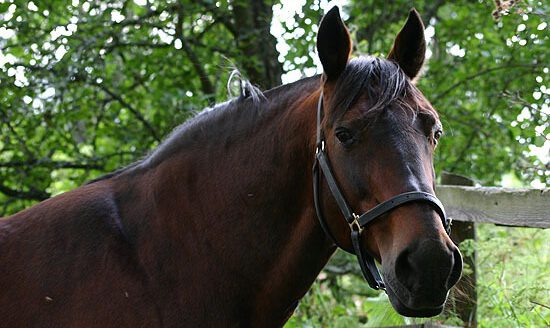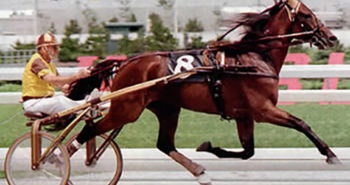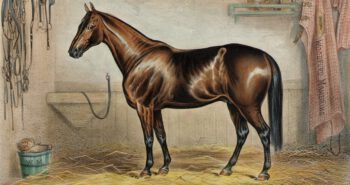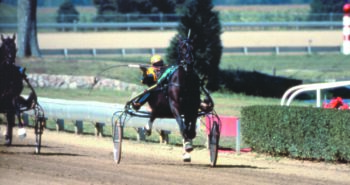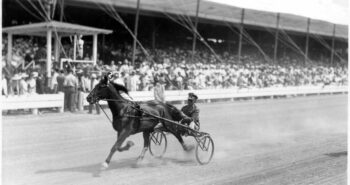When Juhani Lagerstam started the Laukko trotting stud farm at Vesilahti in Finland he needed a few stallions to use on his many broodmares. The first stallion bought was Super Male, a very average stallion, but the second purchase, Choctaw Brave, imported to the land of the thousand lakes in 1981, changed absolutely everything.
Trained by Howard Beissinger, Choctaw Brave was bred by Robert Mumma and owned by his wife and Beissinger’s wife Ann during his US racing career. The same Beissinger-Mumma combination had previously bred, owned and trained Speedy Somolli with great success, and there were reasons to be hopeful for this son of Speedy Crown as well. Choctaw Brave was one of five starters in the first race for 2-year-olds in 1979, and made his debut as early as May 16 that year. In a race with five starters at the Red Mile, Choctaw Brave and Sherry Hanover were sitting last at the three-quarter pole, but at the finish line the Hickory Smoke-daughter won in 2:08.1 (1.19,7), Choctaw Brave narrowly beaten by a head.
Beissinger clearly saw a lot of potential in him at 2. When finishing fifth in the Hickory Pride Trot in June, Beissinger said he had never seen a group of two-year-olds crowd together so much as in that race and added that “It didn’t matter that I was driving the best horse, I just couldn’t find a way out.” Being boxed in meant he had a fresh horse in the Battle of Saratoga five days later, which Choctaw Brave then won comfortably in 2:06.1 (1.18,4).
In the hands of Howard Beissinger, Choctaw Brave also won the John Simpson Stakes, the Hanover-Hempt Stake, Review Futurity and two legs in The Toddler Series at 2, finishing the year 6-7-5 in 24 starts with a mark of 2:01.2 (1.15,5) and earnings of $61,462.
A disappointing season
Choctaw Brave was ranked fourth in the USTA Experimental ratings in 1979 with an expected time of 1:57.3 (1.13,1) at 3. That prediction would prove to be optimistic, though. His 3-year-old season was, in fairness, a disappointment given his early promise as his 24 starts at 3 yielded a 0-2-3 record.
He picked up some money here and there, but usually ended up in the middle of the pack, illustrated by his 4th place finish in the Yonkers Trot, him finishing 5-6 in the 1980 Hambletonian at DuQuoin (won by Burgomeister) and 5-7 in the Kentucky Futurity. The colt then picked up a career-ending hock injury at the end of the season.
Moving to Finland
Covering a few mares in 1981, Beissinger was looking to offload Choctaw Brave cheaply as he didn’t see any big stallion potential or prospects in the US. His performances were not good enough to attract the right kinds of mares and he could no longer race. Choctaw Brave had one thing going for him, though: a really nice pedigree, as he was by Beissinger’s star trotter Speedy Crown. His sister Ahhhh had won the 1978 Merrie Annabelle and his grandam Sprite Rodney was a Matron winner who also finished second in the 1962 Yonkers Trot. Additionally, he was known as a gentle and very well-mannered horse that simply was a joy to handle.
Though American breeders weren’t interested, Juhani Lagerstam in Finland found Choctaw Brave an interesting prospect. Additionally, the price was really low. One factor was most likely Choctaw Brave’s smaller size, the colt measured 156 cms (less than 15,2 hands), but there was another bigger reason: Choctaw Brave was a cryptorchid. Cryptorchidism generally means lower fertility and in most European countries it disqualifies a horse from being allowed to stand stud at all. National rules in Finland meant Choctaw Brave could only be used on the mares Lagerstam owned (the so-called “owners’ mares” exception), but he could not service any other mares. Since the price was low and Lagerstam had quite a few mares on his own that Choctaw could breed, the Finn decided to gamble, importing the stallion to Finland in the fall of 1981.
Kicking the problem and the myth around it
Choctaw Brave’s first Finnish crop, born in 1983, is small and consist of seven foals – all “Laukko” horses bred by Lagerstam per the “owners’ mares” rule. However, at the end of 1982, his veterinarian discovered that the undescended testicle had descended. With the stallion no longer a cryptorchid, Lagerstam suddenly had a public stallion who was very attractive to Finnish breeders.
Over time, a story started circulating that the problem had been eliminated in a rather bizarre fashion: When Choctaw Brave was bred to one of Lagerstam’s more temperamental mares, she supposedly wanted nothing to do with the well-bred son of Speedy Crown and kicked out so the stallion fell off. In a bizarre twist of fate, the undescended testicle descended.
Modern science, however, struggles to explain how testicle could descend because of a sour broodmare’s kick. Pekka Yli-Houhala, who trained Lagerstam’s horses, is also very skeptical.
“It was just good luck, that the other testicle descended. The thing about a mare kicking Choctaw, I think that only a story without any basis in reality. I’ve heard the story several times later, of course, but not from Lagerstam or anybody at Laukko at that time. That said, I can’t say for sure that it didn’t happen, but I think it was nature taking its time. It has happened with other cryptorchids, too.”
A blessing
The whole thing turned out to be a blessing, not only for Lagerstam, but also for Finnish trotting. Chark Laukko, from the stallion’s first small crop, gave a warning of what was to come when he won the Finnish Criterium, the biggest race for 3-year-olds, back in 1986. The following year Domino Laukko won ahead of Dynamite Laukko – and the Choctaw Brave revolution was firmly underway. Pekka Yli-Houhala was not surprised.
“We trained Choctaw a little bit the first winter he was there, and he could trot. He had a hock injury on the right side and I remember he could was a quite nervous type on the track, but otherwise he was a very kind and nice horse. Choctaw Brave was an amazing stallion, he had so many good sons and daughters. They all seemed to inherited his natural gait, they were all very fast, but some of them were also nervous.”
A few years later, 1988, saw the birth of one of the best , if not the very best, Finnish-born trotter, Houston Laukko. Oddly enough, in the same crop was also Isla J Brave, Choctaw Brave’s second best foal. The former took Pekka Yli-Houhala on a fantastic international journey which included group I-wins in France (the 1995 Grand Criterium de Vitesse where he beat Coktail Jet, Abo Volo, Ina Scot and Toss Out), Italy (the 1995 Gran Premio Costa Azzurra where he beat Ina Scot and Toss Out), and Sweden (The 1995 Hugo Åbergs Memorial and the 1994 Åby Stora Pris, in the latter he defeated Copiad, Sea Cove, Queen L and Shan Rags).
“Houston Laukko was one of the favorites ahead of the 1994 Prix d’Amerique. We finished sixth, but the following year we won the Grand Criterium in Cannes-sur-mer. That was a big highlight. Houston Laukko was a great trotter. I also remember I sister of him that I trained. She was tough, some of Choctaw Brave’s daughters could be tough. Her knees were not good at all, but she still earned 100.000 euros,” Yli-Houhala recalls.
Choctaw Brave would go on to sire 1395 foals and many would say he’s the best stallion that has ever stood in the land of the thousand lakes. He produced numerous classical winners. Domino Laukko and Ebony Eyes won both the Kriterium and Derby. Additionally Farmer’s Future and Chark Laukko won the Kriterium while Houston Laukko and Obelix Laukko also won the Derby. His best get, however, were the international stars Houston Laukko, Isla J Brave and Indian Silver. He was champion stallion in Finland from 1989 to 1992, inclusive, as well as 1996. When Choctaw Brave died in February 2008, aged 31, he was the most successful stallion in Finnish history.
Choctaw Brave
Bay colt born in Hanover, PA on Apr 30, 1977. Died in Vesilahti, Finland on Feb 18, 2008.
Speedy Crown – Pizzazz (Ayres)
48 starts: 6-9-8 – Fastest winning: 2,2:01.2 (1.15,5) – Fastest time: 1:57.2 (1.13,0) – $125,587
Breeder: Robert Mumma
Owners: Ann Beissinger and Barbara Mumma – Juhani Lagerstam – Erkki Lagerstam
Trainer: Howard Beissinger
Drivers: Howard Beissinger, Joe O’Brien
Groom: Daniel Gill

